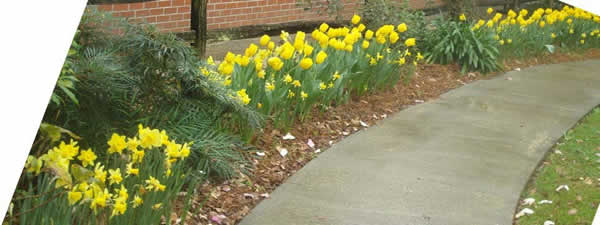April presents us with more opportunities to expand our gardening activities. April affords us additional warm or hot-weather vegetables to plant. April allows us to plant many vegetables that will be more productive if planted this month instead of waiting. The earlier certain vegetables are planted, the more productive they are. Especially if they can avoid very high temperatures when they are at the peak of their productive cycle and also if they are less challenged by insect pests. Vegetables that are recommended to be planted in April are cantaloupe, collards, corn, cucumber, eggplant transplants, snapbeans, Southern peas, squashes, watermelon and tomato transplants. Tomatoes are staked to keep the plants form sprawling on the ground where the fruit would be more likely to rot. Wait for the first flowers to appear, and place the stake on the opposite side of the plant’s stem. All of the flower clusters will grow from the same side of the stem and this will keep developing fruit from getting caught between the stake and the stem.
For those who love to plant herbs, basil, sesame, lemon balm, mints, lemon grass, lemon verbena and rosemary can be planted in April. Excellent hot weather vegetables that can be planted in late April include eggplant, peanuts, pumpkin, Southern peas, hot pepper, lima beans, luffa gourds, and okra.
Pruning of spring flowering shrubs such as spirea, viburnum, quince, azalea, camellia, jasmine and mock orange can be done as soon as they complete their blooming period. Remember though, that pruning should be the result of a specific purpose. Unless you are trying to achieve a clipped formal hedge, pruning should be done to preserve the natural shape of the shrub. Clipping or shearing creates a hedge look, but if you’re trying to lower the height of a shrub, selective pruning should be done by taking the tallest branch or shoot and lowering it by cutting down into the shrub. Then take the next longest and continue this procedure, moving on to the next tallest branch until the shrub is lowered to the desired height. By selectively pruning, you preserve the more natural shape of the shrub instead of shearing across the top making it look more like a hedge.
Be sure to mulch newly planted beds or shrubs or bedding plants with a 1 -2 inch layer of leaves, pine straw, pine bark, or other organic material. The benefits of mulching include suppression or control of weeds, conservation of moisture, reduced soil compaction, and improved soil structure. As mulch decomposes, it provides nutrients to the plants and moderates soil temperatures.
Generally, during hot dry weather spider mites become active and the damage may show up on many vegetables and ornamentals. Spider mites are not easily detected by the naked eye. Using a magnifying glass to inspect the plants, look for tiny red or green eight-legged mites. The foliage of infested plants appears dull, dusty and unhealthy, and eventually turns brown. The spider mites are located primarily under the leaves. Spray with a horticultural oil, insecticidal soap, Malathion or a miticide called Kelthane.
Plant caladiums this month. Caladiums are excellent for shady areas and combine beautifully with ferns, begonias, liriope, impatiens, hosta and coleus. Some outstanding perennials that many nurseries have available at this time of the year in gallon containers include perennial salvia, bee balm, butterfly weed, chrysanthemum, coneflower, coreopsis, four – o’clock, gaillardia, gerbera daisy, daylily, mallow, Goldsturm rudbeckia, sedum, Shasta daisy, stokesia, verbena, yarrow, and violets. Even though some nurseries may still have cool season annuals for sale, think twice before purchasing those for transplanting since cool season annuals will struggle in hot temperatures. Even though petunia will tolerate some heat, even the heat-tolerant ones like the Wave series may last longer but still tend to struggle in the intense heat in late June and into July and August.
Azaleas with leaves that have tiny light spots all over them have been attacked by the azalea lace bugs. Treat with Malathion or Orthene (acephate) as needed through the summer and fall. Any damage that has already occurred will not go away, but insecticide applications will prevent further damage. Spray crape myrtles with mancozeb, chlorothalonil, or other labeled fungicides to control powdery mildew. Powdery mildew appears as a white powdery material on the leaves. Unlike many fungus diseases that are worse during rainy weather patterns, this disease is favored by humid, warm weather without rain. Powdery mildew can also be a problem on a variety of other landscape plants such as dogwood, euonymus, gerbera daisy, rose and hydrangea.
Gerald P. Roberts, Horticulturist/Master Gardener Program Coordinator


 RSS Feed
RSS Feed